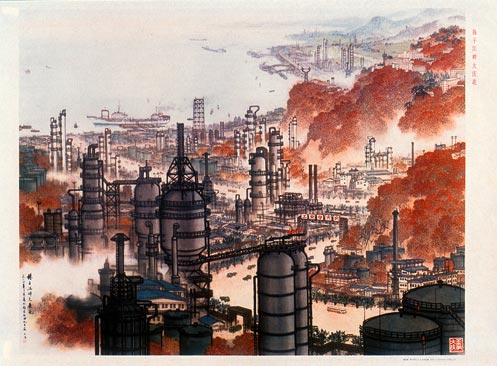 Manufacturing capabilities can be represented by a continuum that is made of four characteristics, flexibility, production rates, production volumes, and changeover time. By looking at the various mixtures of these characteristics it is easy to see what types of manufacturing occupy the different sections in the continuum. At one end of the spectrum is the production line that has multiple work cells that are coordinated to work quite well together. This line produces a high volume of finished products and runs at a high production rate. The line also has drawback of being longer to re-configure to make a production run of products that are totally dissimilar to the products that are in a prior production run. This characteristic gives the production line very little flexibility in being able to move from one production job to the next.
Manufacturing capabilities can be represented by a continuum that is made of four characteristics, flexibility, production rates, production volumes, and changeover time. By looking at the various mixtures of these characteristics it is easy to see what types of manufacturing occupy the different sections in the continuum. At one end of the spectrum is the production line that has multiple work cells that are coordinated to work quite well together. This line produces a high volume of finished products and runs at a high production rate. The line also has drawback of being longer to re-configure to make a production run of products that are totally dissimilar to the products that are in a prior production run. This characteristic gives the production line very little flexibility in being able to move from one production job to the next.
On the other end of the continuum is production that is done by independent work cells. The changeover time between production jobs for these machines is fairly short, which gives them very good flexibility. However, since the devices are not linked together by automation the unit volume and the production rates for this equipment is very low. This production scenario is ideal for producing small batches of products that do not require high speed production to complete. It is easy to see how this scenario can effectively make products that are of the same family of parts because very little changeover is required between production jobs.
Flexible manufacturing automation is the center part of the continuum. It occupies this spot because of the need to draw the best parts from both of the ends of the spectrum to create a type of manufacturing that can perform at an optimum. Flexible manufacturing automation has medium performance in the areas that occupy both ends of the continuum, changeover time, unit volume, production rates, and flexibility. This type of manufacturing Performance Of Service Sector offers several excellent advantages to a company. Flexible manufacturing automation, because of its configuration, has the ability to produce similar products at the same time. As long as the products are of similar design and can utilize the same work cell operations in their creation, it is possible to have these products created at the same time. Imaginative programming of controllers allows this kind of task to be done.
That same programming will be able to make correct decisions about the disposition of dissimilar parts that are fed to the manufacturing operation in a random fashion. Parts that are designed as a widget A will be routed through the series of production centers that are particular to its requirements, while widget B will be sent through those work centers that are particular to it. Some of these work cells maybe the same and some of them may be different in completing each of these part types from the same part family. As indicated before, the controller must have each part be identified so that a decision by the program can be made about its disposition. The only way that this can be accomplished effectively is to have the proper production planning and program design in place.
Flexible manufacturing automation, under the circumstances described above, will yield efficient device utilization. There can be several products that have slight variations in their production that can be produced during the same production job. It is important for product designers to create designs that will allow for the efficient manufacture of this similar products in a single manufacturing run.
Because of the way that flexible manufacturing automation is configured in the plant, the setup time for changing to a new production job can be minimal compared to traditional manufacturing. As a production manager in the early part of my career, it was responsibility to decide the order of production jobs in a manufacturing operation. It was very important to try to schedule consecutive jobs that had as few device changes as possible. This would minimize down time between Brand Analysis Pdf production runs and optimize the use of equipment. With flexible automation the process of changeover is simplified and shortened. Tooling for any production run can be set up while a different production run is in process. When one job completes the new tooling can be made available to the devices for the next job to start. In some production scenarios tooling for several jobs is set up in advance and will be available to the production devices at any time they are needed.
Reduced direct and indirect labors costs is a great benefit of flexible automation. In the old days there was one or even more human operators for each work cell on the production line, not6 to mention the labor that was required at the beginning and the end of the line. With flexible manufacturing automation most of the time the operators needed are reduced significantly. These costs are reduced because there is automation handling materials rather than humans. Control is done by automation rather than humans. Set up and tooling is done off-line.
